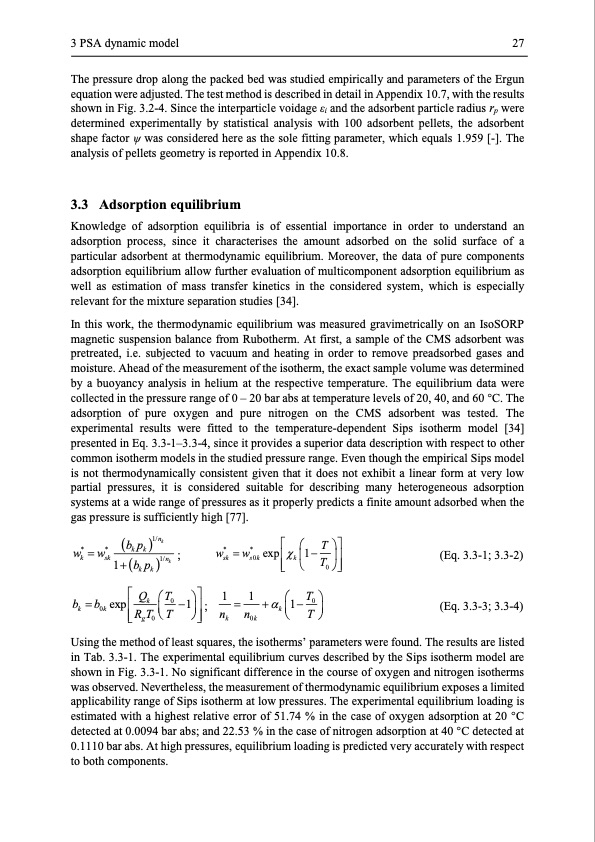
PDF Publication Title:
Text from PDF Page: 040
3 PSA dynamic model 27 The pressure drop along the packed bed was studied empirically and parameters of the Ergun equation were adjusted. The test method is described in detail in Appendix 10.7, with the results shown in Fig. 3.2-4. Since the interparticle voidage εi and the adsorbent particle radius rp were determined experimentally by statistical analysis with 100 adsorbent pellets, the adsorbent shape factor ψ was considered here as the sole fitting parameter, which equals analysis of pellets geometry is reported in Appendix 10.8. 3.3 Adsorption equilibrium Knowledge of adsorption equilibria is of essential importance in order to understand an adsorption process, since it characterises the amount adsorbed on the solid surface of a particular adsorbent at thermodynamic equilibrium. Moreover, the data of pure components adsorption equilibrium allow further evaluation of multicomponent adsorption equilibrium as well as estimation of mass transfer kinetics in the considered system, which is especially relevant for the mixture separation studies [34]. In this work, the thermodynamic equilibrium was measured gravimetrically on an IsoSORP magnetic suspension balance from Rubotherm. At first, a sample of the CMS adsorbent was pretreated, i.e. subjected to vacuum and heating in order to remove preadsorbed gases and moisture. Ahead of the measurement of the isotherm, the exact sample volume was determined by a buoyancy analysis in helium at the respective temperature. The equilibrium data were collected in the pressure range of 0 – 20 bar abs at temperature levels of 20, 40, and 60 °C. The adsorption of pure oxygen and pure nitrogen on the CMS adsorbent was tested. The experimental results were fitted to the temperature-dependent Sips isotherm model [34] presented in Eq. 3.3-1–3.3-4, since it provides a superior data description with respect to other common isotherm models in the studied pressure range. Even though the empirical Sips model is not thermodynamically consistent given that it does not exhibit a linear form at very low partial pressures, it is considered suitable for describing many heterogeneous adsorption systems at a wide range of pressures as it properly predicts a finite amount adsorbed when the gas pressure is sufficiently high [77]. w* =w* k sk 1/n (bp)k T w* =w* exp 1− k k 1+(bp) ; sk s0k k 0 (Eq.3.3-1;3.3-2) (Eq.3.3-3;3.3-4) 1.959 [-]. The 1/n k T kk b =b exp Qk T0 −1 1 = 1 + 1−T0 k 0k RT T ; n n k T g0 k 0k Using the method of least squares, the isotherms’ parameters were found. The results are listed in Tab. 3.3-1. The experimental equilibrium curves described by the Sips isotherm model are shown in Fig. 3.3-1. No significant difference in the course of oxygen and nitrogen isotherms was observed. Nevertheless, the measurement of thermodynamic equilibrium exposes a limited applicability range of Sips isotherm at low pressures. The experimental equilibrium loading is estimated with a highest relative error of 51.74 % in the case of oxygen adsorption at 20 °C detected at 0.0094 bar abs; and 22.53 % in the case of nitrogen adsorption at 40 °C detected at 0.1110 bar abs. At high pressures, equilibrium loading is predicted very accurately with respect to both components.PDF Image | Modelling and Simulation of Twin-Bed Pressure Swing Adsorption Plants

PDF Search Title:
Modelling and Simulation of Twin-Bed Pressure Swing Adsorption PlantsOriginal File Name Searched:
dissertation_marcinek.pdfDIY PDF Search: Google It | Yahoo | Bing
CO2 Organic Rankine Cycle Experimenter Platform The supercritical CO2 phase change system is both a heat pump and organic rankine cycle which can be used for those purposes and as a supercritical extractor for advanced subcritical and supercritical extraction technology. Uses include producing nanoparticles, precious metal CO2 extraction, lithium battery recycling, and other applications... More Info
Heat Pumps CO2 ORC Heat Pump System Platform More Info
| CONTACT TEL: 608-238-6001 Email: greg@infinityturbine.com | RSS | AMP |